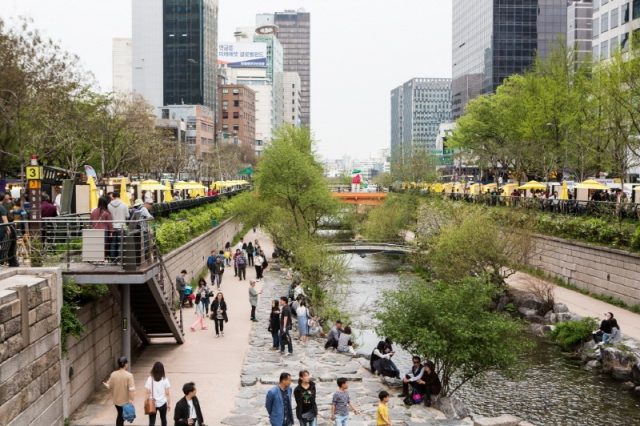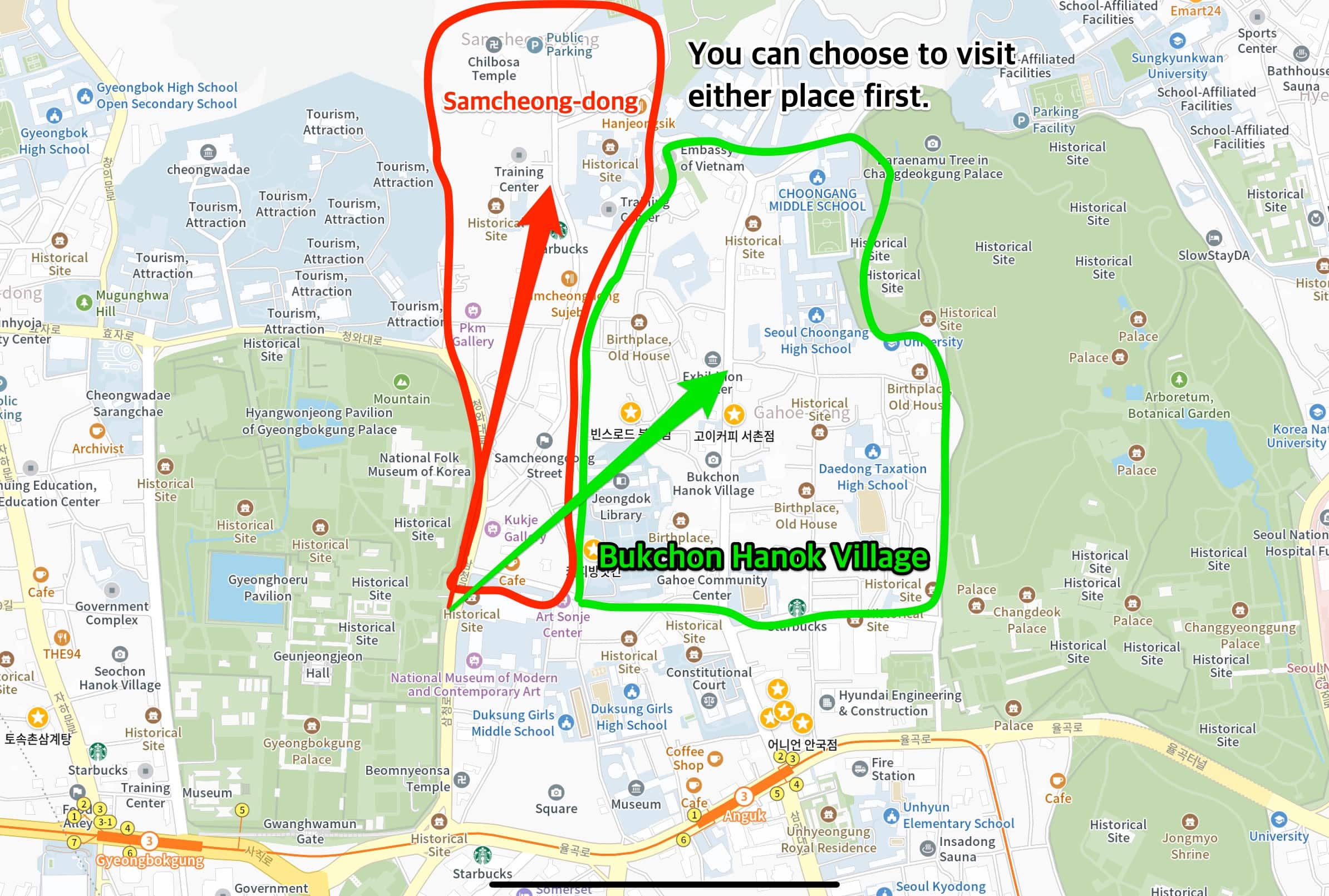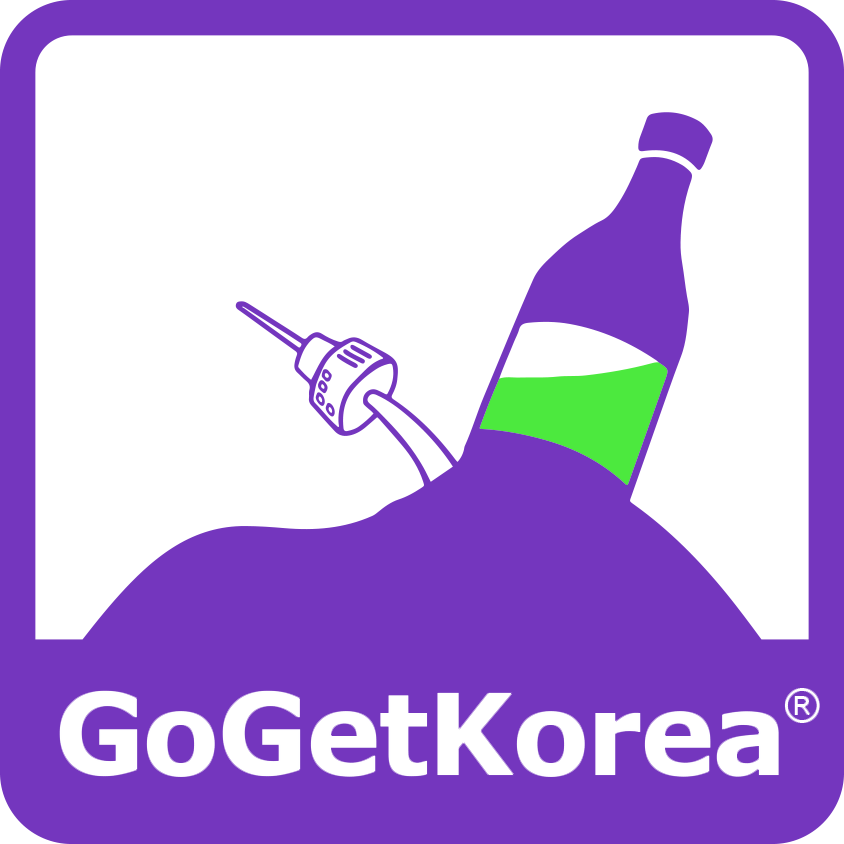The tourist attractions included in this itinerary








Immerse yourself in Seoul’s rich history and heritage as you explore iconic landmark places, and traditional Hanok village.
The Route
Note: This area is entirely walkable. However, you can still check the subway exits for each attraction in case you prefer to visit them separately.
1. Gwanghwamun Plaza 광화문 광장
Experience the vibrant atmosphere of Gwanghwamun Plaza, a historical and cultural hub in Seoul.
Additional Information: Gwanghwamun Plaza is located in front of Gyeongbok Palace (Gyeongbokgung), one of the main palaces in Seoul. The name “Gwanghwamun” refers to the gate of the palace (known as “Mun” in Korean), and the plaza itself is a significant historical and cultural hub in the city.


- Subway: Exit 2 or 9 of Gwanghwamun Station line no.5 (purple line)
- Highlights:
- Capture a photo of the statues of King Sejong, the creator of Hangeul, and Admiral Lee, renowned for his victory over the Japanese navy with his turtle war-ships.
- Don’t miss the new free exhibit about Hangeul located beneath King Sejong’s Statue.
- Tip: For a scenic view from above, exit from No.9.
- Estimated Time for this activity: 1 hour.
2. Gyeongbok Palace 경복궁
Immerse yourself in the grandeur of Gyeongbok Palace, a majestic palace that showcases traditional Korean architecture.


- Subway: Exit 5 of Gyeongbokgung Station, line no.3 (orange line)
- Opening Hours:
- Mar, Apr, May, Sept. & Oct.: 09:00-18:00
- Jun, Jul & Aug: 09:00-18:30
- Nov & Dec: 09:00-17:00
- Closed on Tuesdays
- Admission:
- 3,000 Won
- 1,500 Won age between 7 – 18
- Free of Charge age between 1-6 and over age 65
- Free for Korean under age 24
- Free Language Guide Service:
- English: 11:00, 13:30 & 15:30 (3 times a day)
- Japanese:10:00, 12:30 & 14:30 (3 times a day)
- Chinese:9:30, 11:00, 13:30, 15:00 & 16:30 (4 times a day)
- Events inside Gwanghwamun Gate:
- Public training of the Royal Guard soldiers: 09:35, 13:35 (for 15 minutes)
- Royal Guards Changing Ceremony: 10:00 & 14:00 twice a day all year round (for 20 minutes)
- Ceremony of guarding Gwanghwamun Gate: 11:00, 13:00 (for 10 minutes) After the ceremonies for changing and keeping guard, the soldiers go on sentry for Gwanghwamun Gate (per hour).
- Wearing Royal Guard costumes is suspended due to COVID-19 (until further notice).
- Things to do: Embark on a comprehensive tour of Gyeongbok Palace, which includes visiting the National Palace Museum of Korea and the National Folk Museum of Korea.
- Tip: Begin your journey at National Palace museum of Korea on the left side within the palace grounds. Explore Gyeongbok Palace, visit National Folk Museum and conclude your visit with a leisurely walk to the nearby Bukchon Hanok Folk Village.
- Estimated Time for this activity: 3 – 4 hours.
- For Hanbok rental, we recommend visiting ‘Yes Hanbok‘ located at 133-6 Sajik-ro, Jongno-gu, Seoul / 서울 종로구 사직로 133-6. This area offers a wide selection of other places for Hanbok rental as well, providing you with various options to choose from.


Directions: If you choose to go to Samcheongdong first, be prepared to walk a bit more as it is a straight road. Therefore, I recommend visiting Bukchon Hanok Village before Samcheongdong if you are planning on visiting both.
3. Bukchon Hanok Folk Village 북촌 한옥 마을
Step back in time and explore the charming Bukchon Hanok Folk Village, known for its well-preserved traditional houses.
Fun Fact: There are approximately 900 houses within the village where people still reside. It’s a little secret, so let’s keep it quiet!


- Subway: Exit 2 of Anguk Station, line no.3 (orange line) and walk 10 minutes straight north.
- Address: 37, Gyedong-gil, Jongno-gu, Seoul (the very spot of the picture) / 서울특별시 종로구 계동길 37(계동)
- Things to do: Get a map of Bukchon Hanok Village to discover all the beautiful spots and capture picturesque photos.
- Estimated Time for this activity: 1.5 hours.
4. Samcheongdong 삼청동
Discover the trendy and artistic neighborhood of Samcheongdong, filled with unique boutiques, cafes, and galleries.
Note: Please be aware that prices in this area tend to be higher compared to other neighborhoods.


- Subway: Either Gyeongbokgung or Anguk Station, subway line no.3 (orange line)
- Address: 107, Samcheong-ro, Jongno-gu, Seoul / 서울특별시 종로구 삼청로 107(삼청동)
- Highlights:
- Explore contemporary restaurants and wine bars established in traditional houses.
- Visit art galleries, design shops, specialty shops, and themed museums.
- Estimated Time for this activity: 1 hour.
Directions: To reach this area, exit the National Folk Museum and leave Gyeongbok Palace through the east gate. Continue walking straight to the north.
After exploring Samcheongdong and Bukchon Hanok Village, you have the option to visit Changdeok Palace and/or Changgyeong Palace, which are not included in this itinerary as the main palace is Gyeongbok Palace. However, please note that visiting all three palaces in one day can be quite challenging, so it is not recommended.
5. Insadong 인사동
Dive into the rich cultural heritage of Seoul at Insadong, a bustling district renowned for its traditional crafts, tea houses, and street food.
Note: During weekends, car traffic is prohibited in this area, which is beneficial for pedestrians. However, please be aware that it tends to be more crowded during this time.




- Subway: Exit 6 of Anguk station, subway line no.3 (orange line)
- Opening hours: Most shops open between 9am and 10am and close between 8pm and 10pm. Galleries generally are open 9:00-18:00. Some are free to enter, but not all.
- Highlights:
- Visit art galleries, indulge in souvenir shopping, and savor delicious Korean cuisine or traditional tea at charming restaurants and tea houses.
- Don’t miss the opportunity to try mouthwatering street food and explore the affordable shopping options available.
- Estimated Time for this activity: 1.5 hours.
6. Tapgol Park 탑골 공원
Find serenity in Tapgol Park, a tranquil green space known for its historic significance and beautiful scenery.
Did you know?: As you wander through Jong-gak, you’ll encounter many elderly Koreans engaged in leisure activities such as playing chess, resting, or engaging in friendly conversations.


- Subway: Exit 1 and 5 of Jongro-3ga station, line no.1 (navy blue line).
- Address: 99 Jong-ro, Jongno-gu, Seoul
- Highlights:
- Wander through Jong-gak and observe elderly Koreans engaged in leisure activities such as playing chess, resting, or engaging in friendly conversations.
- Historical Note: Jong-gak holds historical significance as the first park established in downtown Seoul. It was at this location in 1919 that the first 33 representatives of the March 1st Movement recited the Korean Declaration of Independence from Japan, passionately proclaiming “All hail independence.”
- Estimated Time for this activity: 30 minutes
7. Jong-gak 종각
Visit Jong-gak, a bustling area famous for its lively atmosphere, street performances, and vibrant nightlife.
Additional Information: At midnight, in the pavilion, the grand peace bell ‘jong’ is struck, marking the transition to a new year.


- Subway: Exit 4 of Jonggak Station, line no.1 (navy blue line)
- Address: 54, Jong-ro, Jongno-gu, Seoul / 서울특별시 종로구 종로 54(관철동)
- Info: Jonggak has 2 meanings; one is the pavilion where the big bell is placed and the other is the area itself. Jonggak is also called as Bosingak. The bell inside is hit 12 times on the New Year. Thousands of people gather here to celebrate the new year. You would get stepped on by the sheer number of people. This is also one of the best areas for restaurants and pubs in north part of Seoul.
- Estimated Time for this activity: 30 minutes
8. Cheonggyecheon 청계천
Explore the urban oasis of Cheonggyecheon, a revitalized stream that offers a peaceful escape from the city’s hustle and bustle.
Additional Information: The Cheonggyecheon stream is an artificial waterway that utilizes the cooling waters from the Han River, offering respite from the city’s heat. Known as either Cheonggyecheon or Cheonggye stream, it serves as a refreshing and picturesque destination.


- Cheonggye Stream near Joggak Station
- Subway: Exit 4 of Jonggak Station, line no.1 (navy blue line).
- Tip: Stroll along the stream and put your feet in the water in the summer time.
- Estimated Time for this activity: 1 hour.
FAQ about Gyeongbokgung Palace
How much does it cost to go to Gyeongbok palace?
The admission fee for Gyeongbok Palace in Seoul, South Korea, is as follows:
Adults: 3,000 Korean won
Children (ages 7-18): 1,500 Korean won
Please note that the fees mentioned are subject to change, and it’s always a good idea to check the official website or inquire on-site for the most up-to-date information regarding admission prices. Additionally, there may be additional fees for special exhibitions or guided tours within the palace grounds.
Which palace did BTS perform at?
In October 2020, BTS performed their track “Dynamite” at the Geunjeongjeon Grand Residence in Gyeongbokgung Palace. First opened in 1395, it was one of the main palaces in the Joseon dynasty until 1895. With its history and grandeur, it was the perfect backdrop for an epic performance.
In particular, Geunjeongjeon Grand Residence was the throne hall where the kings granted an audience to his officials, made announcements, and greeted foreign visitors. Constructed mainly of wood, the version BTS danced in front comes as part of a reconstruction done in the late 1800s.
Is Gyeongbokgung Palace free if you wear hanbok?
Yes, if you wear hanbok (traditional Korean clothing), you can enter Gyeongbokgung Palace for free. This policy is in place to promote the traditional Korean culture and enhance the visitors’ experience. It provides an opportunity for people wearing hanbok to fully immerse themselves in the historical atmosphere of the palace without having to pay the regular admission fee. However, it’s important to note that this policy may have certain guidelines and restrictions, so it’s recommended to check the official website or inquire at the palace for the most up-to-date information. Visit the official website of Gyeongbokgung Palace
What is the most beautiful palace in Korea?
While opinions on the most beautiful palace may vary, Gyeongbokgung Palace in Seoul is often regarded as one of the most stunning and iconic palaces in Korea. Its grandeur, intricate architectural details, and picturesque surroundings make it a popular choice among visitors. Other notable palaces renowned for their beauty include Changdeokgung Palace, with its beautiful Secret Garden, and Deoksugung Palace, which blends traditional and western architectural styles. Ultimately, the beauty of a palace is subjective, and it is worth exploring multiple palaces to appreciate the distinct characteristics and allure of each one.
When is Gyeongbokgung Palace open?
Gyeongbokgung Palace is generally open from Tuesday to Sunday. The opening hours are as follows:
March to October:
Tuesday to Sunday: 9:00 AM to 6:00 PM
November to February:
Tuesday to Sunday: 9:00 AM to 5:00 PM
Please note that Gyeongbokgung Palace is closed on Mondays, and if Monday is a national holiday, it will be closed on the following Tuesday instead. Additionally, there may be temporary closures or changes in operating hours for special events or maintenance, so it’s advisable to check the official website or contact the palace directly for the most up-to-date information before planning your visit.
What’s the best way to see Gyeongbokgung Palace?
Going with Kimchiman would be the most fun and informative at a reasonable level. The 2nd best way to see Gyeongbokgung Palace is to take a leisurely self-guided tour, exploring the palace grounds at your own pace. Here are some steps to make the most of your visit:
1. Start with the changing of the guard ceremony: Arrive early to witness the traditional changing of the guard ceremony at the main entrance. It usually takes place multiple times a day.
2. Explore the palace grounds: Begin your exploration of the palace by entering through the main gate. Take your time to admire the beautiful architecture, intricate details, and picturesque surroundings. Visit the various halls, pavilions, and gardens within the palace complex.
3. Visit the National Palace Museum of Korea: Located within the palace grounds, the museum offers a comprehensive collection of artifacts and exhibits related to Korean royal history. Take the opportunity to learn more about the palace’s significance and the Joseon Dynasty.
4. Join a guided tour: If you prefer a more structured experience, consider joining a guided tour. There are official guided tours available at the palace, providing in-depth information and historical insights. Check the official website or inquire at the visitor center for tour schedules.
5. Wear hanbok for a unique experience: Consider renting a hanbok (traditional Korean attire) from one of the many rental shops nearby. Wearing hanbok while exploring the palace adds to the immersive experience and provides great photo opportunities. Plus, admission to the palace may be free or discounted if you’re wearing hanbok.
6. Attend cultural programs and events: Keep an eye out for cultural programs and events that may be happening at the palace during your visit. These can include traditional performances, craft demonstrations, and special exhibitions that showcase Korean culture.
Remember to check the opening hours, admission fees, and any special regulations or guidelines on the official website or contact the palace before your visit to ensure a smooth and enjoyable experience.



Awesome!!